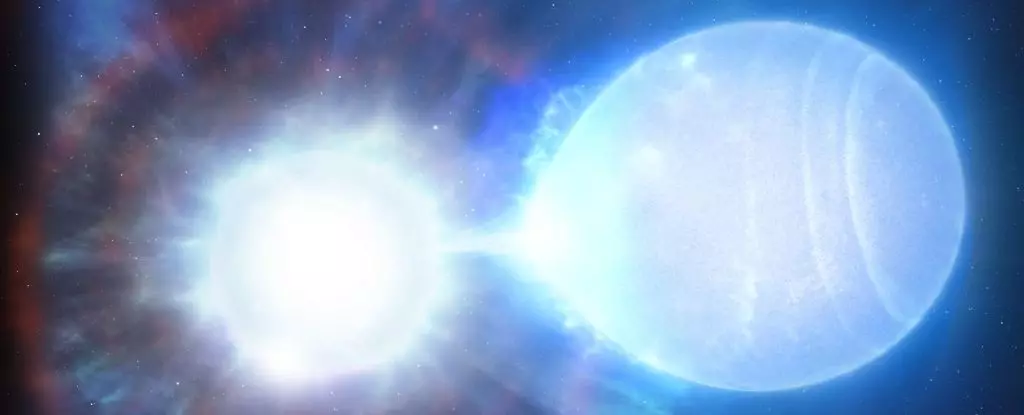The universe is a vast tapestry woven with the lifecycles of stars, each destined to face its demise, and with death comes rebirth in a cosmic sense. Stars serve as the luminous beacons of the night sky, yet their brilliance is ephemeral. Consider the impending fate of a binary star system situated about 150 light-years from Earth. Researchers have recently pinpointed a timeline—23 billion years from now—when two white dwarf stars will collide. However, this cataclysmic event is expected to be preempted by a spectacular Type Ia supernova explosion, acting as a critical element in our understanding of cosmic distances. This groundbreaking revelation not only revokes the previous ambiguity surrounding white dwarf stars and their role in supernovae but confirms the theoretical expectation that a binary system is often the progenitor of such celestial explosions.
Unveiling the White Dwarfs
White dwarfs—once the hearts of sun-like stars—exhibit an intriguing existence after they have consumed their hydrogen fuel. The process isn’t marked by a conventional “death” but more of a transformation; an outward gravitational pressure gives way to an inward collapse under its own weight, ultimately resulting in a stellar remnant. These remnants harbor a density that belies their comparatively small size, holding up to 1.4 times the mass of the Sun within a volume smaller than our Earth. This critical threshold, known as the Chandrasekhar limit, marks the dividing line where stability turns to chaos. When a white dwarf surpasses this limit, it triggers a Type Ia supernova, an explosive event crucial for distributing heavy elements across the universe.
Such supernovae are not merely isolated fireworks of the cosmos; their significance expands with our understanding of cosmic geography. Their predictable brightness allows astronomers to gauge distances far into the depths of space—playing an instrumental role in our understanding of the universe’s expansion.
A Binary Revelation
Despite the theoretical models suggesting that binary white dwarf systems are prime candidates for producing Type Ia supernovae, empirical evidence has been troublesome to acquire. For a binary to produce this explosion, the stars must be in proximity, allowing one to siphon material from the other—pushing it over the Chandrasekhar limit. Historically, such conditions were identified, yet they took far too long to reach fruition, rendering them inadequate given the estimated 13.8 billion-year age of the universe.
However, the discovery of WDJ181058.67+311940.94 marks a significant pivot in this narrative. Researchers confirm that this binary system is not only closer than anticipated but possesses the conditions necessary for a future Type Ia supernova—setting a timeframe that aligns closer to the universe’s age than previously speculated. The stars’ orbits, remarkably close (a mere 1/60th the distance from the Earth to the Sun), assure that they’re on a swift trajectory toward mutual destruction, evolving from a gradual decay of their orbits to a moment of inevitable explosion.
The Significance of Empirical Evidence
This discovery transcends mere academic curiosity; it arms astronomers with verifiable data linking two white dwarfs directly to the genesis of Type Ia supernovae. The prevailing theory before this breakthrough lacked tangible proof, relying heavily on speculation. By establishing a concrete connection, researchers can now refine their methods of discovering similar stellar systems and enrich our comprehension of the cosmos. The implications are vast—scientists can now better explain the high incidence of Type Ia supernovae observed across the Milky Way, correcting course on cosmological models that previously lacked substantiation.
An Altered Perspective on Cosmic Time
Realistically, the timeline leading to the impending explosion of WDJ181058.67+311940.94 showcases a horizon so far into the future it seems innocuous. For humanity, Earth’s fate will likely be sealed long before the binary stars ignite in their celestial dance. By the time this event unfolds, our planet will have undergone drastic changes—our Sun will have evolved into its own white dwarf form, removing humanity from any peril posed by this supernova. Nevertheless, the excitement surrounding this discovery propels a crucial discussion about cosmic scale and time.
At its core, this research reinforces the beauty of scientific inquiry; it emphasizes our innate desire to understand, to connect dots in a universe brimming with mysteries and enigmas. As we strive to map our place in the cosmos, discoveries like these create pathways for future explorations and understandings. The pursuit of knowledge doesn’t merely accumulate facts; it unites us, echoing through the eons as we gaze into the firmament, searching for the stories hidden among the stars.


Leave a Reply